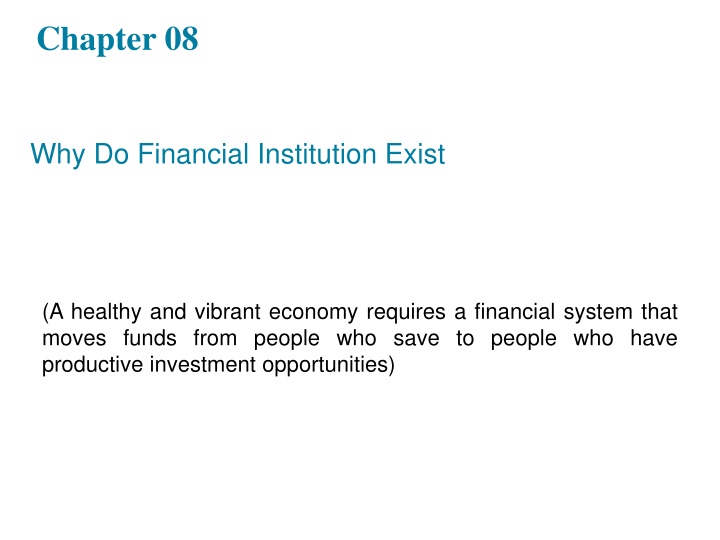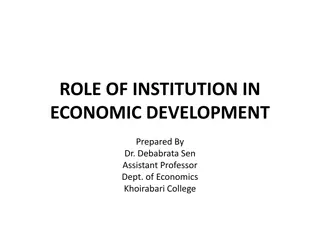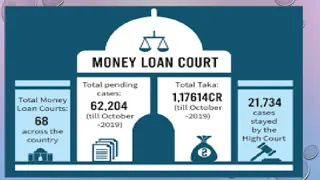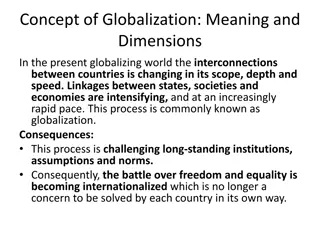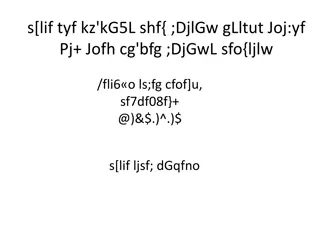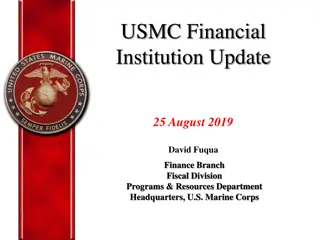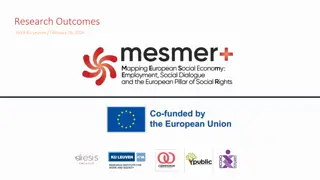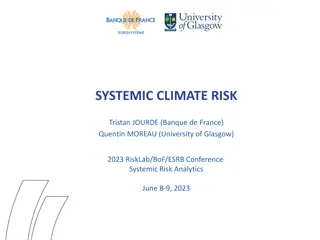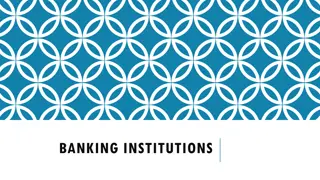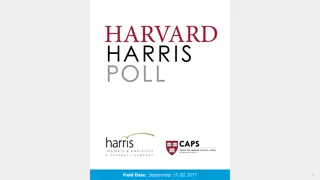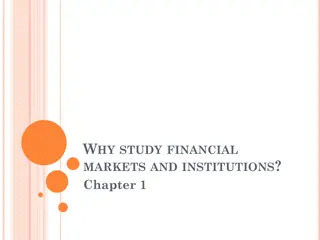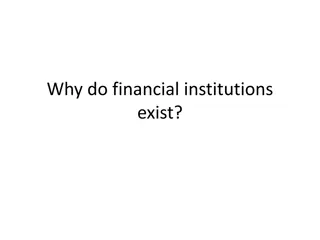Role of Financial Institutions in the Global Economy
Explore the significance of financial institutions in facilitating the flow of funds from savers to productive investments, essential for a healthy economy. Delve into topics like transaction costs, asymmetric information, adverse selection, and moral hazard in the financial system, along with basic facts about financial structures worldwide.
Download Presentation

Please find below an Image/Link to download the presentation.
The content on the website is provided AS IS for your information and personal use only. It may not be sold, licensed, or shared on other websites without obtaining consent from the author.If you encounter any issues during the download, it is possible that the publisher has removed the file from their server.
You are allowed to download the files provided on this website for personal or commercial use, subject to the condition that they are used lawfully. All files are the property of their respective owners.
The content on the website is provided AS IS for your information and personal use only. It may not be sold, licensed, or shared on other websites without obtaining consent from the author.
E N D
Presentation Transcript
Chapter 08 Why Do Financial Institution Exist (A healthy and vibrant economy requires a financial system that moves funds from people who save to people who have productive investment opportunities)
Learning Objectives Identify eight basic facts about the global financial system. Summarize how transaction costs affect financial intermediaries. Describe why asymmetric information leads to adverse selection and moral hazard. Recognize adverse selection and summarize the ways in which they can be reduced. Recognize the principal-agent problem arising from moral hazard in equity contracts and summarize the methods for reducing it. Summarize the methods used to reduce moral hazard in debt contracts.
Figure 1 Sources of External Funds for Nonfinancial Businesses: A Comparison of the United States with Germany, Japan, and Canada Source: Andreas Hackethal and Reinhard H. Schmidt, Financing Patterns: Measurement Concepts and Empirical Results, Johann Wolfgang Goethe-Universitat Working Paper No. 125, January 2004. The data are from 1970 2000 and are gross flows as percentage of the total, not including trade and other credit data, which are not available.
Basic Facts About Financial Structure Throughout the World (1 of 2) 1. Stocks are not the most important sources of external financing for businesses. 2. Issuing marketable debt and equity securities is not the primary way in which businesses finance their operations. 3. Indirect finance is many times more important than direct finance 4. Financial intermediaries, particularly banks, are the most important source of external funds used to finance businesses.
Basic Facts About Financial Structure Throughout the World (2 of 2) 5. The financial system is among the most heavily regulated sectors of the economy. 6. Only large, well-established corporations have easy access to securities markets to finance their activities. 7. Collateral is a prevalent feature of debt contracts for both households and businesses. 8. Debt contracts are extremely complicated legal documents that place substantial restrictive covenants on borrowers.
Transaction Costs Making a restricted number of investments limits your ability to carry out diversification Bundling investors funds together, financial intermediaries have evolved to reduce transaction costs. Economies of scale Expertise A mutual fund is a financial intermediary that sells shares to individuals and then invests the proceeds in bonds or stocks.
Asymmetric Information: Adverse Selection and Moral Hazard Adverse selection occurs before a transaction occurs. Big risk-takers are the often most eager to take out a loan ex-ante. Moral hazard arises after the transaction has developed. Borrowers may engage in risk-taking activities ex-post. Agency theory analyses how asymmetric information problems affect economic behavior.
The Lemons Problem: How Adverse Selection Influences Financial Structure If quality cannot be assessed, the buyer is willing to pay at most a price that reflects the average quality. Sellers of good quality items will not want to sell at the price for average quality. The buyer will decide not to buy at all because all that is left in the market is poor quality items. This problem explains fact 2 and partially explains fact 1.
Tools to Help Solve Adverse Selection Problems Private production and sale of information Free-rider problem Government regulation to increase information Not always works to solve the adverse selection problem, explains Fact 5 Financial intermediation Explains facts 3, 4, & 6 Collateral and net worth Explains fact 7
The Enron Implosion Enron Corporation declared bankruptcy in December 2001, up to that point the largest bankruptcy declaration in U.S. history The Enron collapse illustrates that government regulation can lessen asymmetric information problems but cannot eliminate them. The Enron bankruptcy not only increased concerns in financial markets about the quality of accounting information supplied by corporations but also led to hardship for many of the firm s former employees, who found that their pensions had become worthless
How Moral Hazard Affects the Choice Between Debt and Equity Contracts Called the Principal-Agent Problem: Principal: less information (stockholder) Agent: more information (manager) Separation of ownership and control of the firm Managers pursue personal benefits and power rather than the profitability of the firm.
Tools to Help Solve the Principal-Agent Problem Monitoring (Costly State Verification) Free-rider problem Fact 1 Government regulation to increase information Fact 5 Financial Intermediation Fact 3 Debt Contracts Fact 1
How Moral Hazard Influences Financial Structure in Debt Markets Borrowers have incentives to take on projects that are riskier than the lenders would like. This prevents the borrower from paying back the loan.
Tools to Help Solve Moral Hazard in Debt Contracts Net worth and collateral Incentive compatible Monitoring and enforcement of restrictive covenants Discourage undesirable behavior Encourage desirable behavior Keep collateral valuable Provide information Financial intermediation Facts 3 & 4
Summary Table 1 Asymmetric Information Problems and Tools to Solve Them (1 of 2) Asymmetric Information Problem Adverse selection Tools to Solve It Explains Fact Number 1, 2 Private production and sale of information Blank Government regulation to increase information Financial intermediation 5 Blank 3, 4, 6 Blank Collateral and net worth 7 Moral hazard in equity contracts (principal agent problem) Blank Production of information: monitoring 1 Government regulation to increase information Financial intermediation 5 Blank 3 Blank Debt contracts 1
Summary Table 1 Asymmetric Information Problems and Tools to Solve Them (2 of 2) Asymmetric Information Problem Moral hazard in debt contracts Blank Tools to Solve It Explains Fact Number 6, 7 Collateral and net worth Monitoring and enforcement of restrictive covenants Financial intermediation 8 Blank 3, 4 Note: List of facts: 1. Stocks are not the most important source of external financing. 2. Marketable securities are not the primary source of financing. 3. Indirect finance is more important than direct finance. 4. Banks are the most important source of external funds. 5. The financial system is heavily regulated. 6. Only large, well-established firms have access to securities markets. 7. Collateral is prevalent in debt contracts. 8. Debt contracts have numerous restrictive covenants.
Application: Financial Development and Economic Growth (1 of 2) Financial repression created by an institutional environment is characterized by: Poor system of property rights (unable to use collateral efficiently) Poor legal system (difficult for lenders to enforce restrictive covenants) Weak accounting standards (less access to good information) Government intervention through directed credit programs and state-owned banks (less incentive to proper channel funds to its most productive use)
Application: Financial Development and Economic Growth (2 of 2) The financial systems in developing and transition countries face several difficulties that keep them from operating efficiently. In many developing countries, the system of property rights (the rule of law, constraints on government expropriation, absence of corruption) functions poorly, making it hard to use these two tools effectively.
The Tyranny of Collateral To use property, such as land or capital, as collateral, a person must legally own it. Unfortunately, it is extremely expensive and time-consuming for the poor in developing countries to make their ownership of property legal. When the financial system is unable to use collateral effectively, the adverse selection problem worsens because the lender needs even more information about the quality of the borrower in order to distinguish a good loan from a bad one. Little lending will take place, especially in transactions that involve collateral, such as mortgages.
